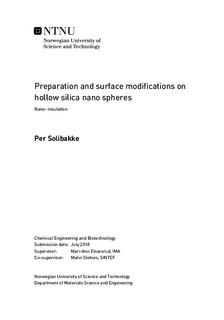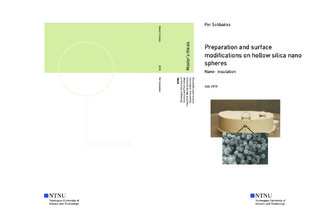| dc.description.abstract | Hollow silica nano spheres (HSNS) were synthesised with the use of polystyrene templates. Based on the polystyrene templates, tetraethyl orthosilicate (TEOS) was hydrolysed and attached on the surface, in either an acidic or basic environment. The acidic catalyst, HCl and the basic catalyst, NH4OH were investigated to determine the reaction yield and morphology generation. By repetitive experiments a hypothesis was developed. The morphology outcome is valid for an ammonia solution with a m% of NH3 between 10 % to 30 %. The morphology of the attached silica and agglomeration of spheres were determined not to correspond directly with the pH, but rather the addition of ammonia solution. Moreover, the as - synthesised HSNS were modified by three separate surface modifications, to increase the hydrophobicity and reduce the brittleness. A hydroxylation process was necessary to re - attach hydroxide molecules, removed during heat treatment, for further modification. The hydroxylated HSNS exhibited moderate re - attachment of hydroxide molecules in basic water, providing that the required surface conditions. To increase the hydrophobicity a hydrophobisation process was attempted. HSNS were submerged in 20 % to 30 % hexamethyldisiloxane (HMDS), to attach large organic molecules on to the silica surface. The surface modification did not alter the hydrophobicity, nor did it effect the composition and morphology of the as - synthesised HSNS samples. To reduce the brittleness, a functionalisation process was developed. Vinyltrimeth- oxysilane (VMOS) was investigated, to analyse what effects, the attachment of C = C bonds with large organic molecules on the silica surface, had on the hydrophobicity and thermal conductivity. For all functionalised HSNS, successful attachment of C = C bonds was confirmed, along with a drastic transformation of hydrophobicity. A super hydrophobic material was created, with respect to a contact angle (θ) > 150 ◦ measured for all functionalised HSNS samples. The attachment of organic molecules and C = C bonds did not alter the thermal conductivity and the C = C bonds provides possibilities for continued modific- ation of the material, reducing the brittleness.
The as - synthesised and surface modified HSNS were characterised with respect to their morphology (SEM) and composition (FTIR). The functionalised HSNS, along with their corresponding hydroxylated precursor, were characterised with respect to their hydrophobicity (contact angle). Selected as - synthesised and functionalised HSNS were characterised with respect to their thermal conductivity (Hot disk). | |

